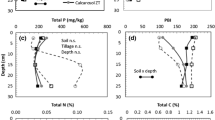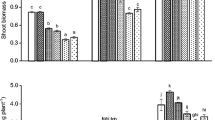Abstract
Nine heavily fertilized soils were collected from southern and central Norway. A greenhouse experiment in the phytotron was conducted to evaluate the P supplying capacities of these soils at different temperatures (9, 12 and 18 °C). The crops were grown in succession and the sequence was oat, rye grass (cut twice), oat, rape and oat. Effect of temperature on dry matter (DM) yield and P uptake was more marked up to the fourth crop but the effect varied among crops. The DM yields of oat and rape increased with increasing temperature but the opposite was the case with rye grass. The yield differences among soils at 12 °C were highly significant (p < 0.01) in contrast to 9 and 18 °C. The amount of P taken up by plants in these soils was highest at 18. °C. The P supplying capacity was highest in the soils with higher content of organic P. Generally, the soils of very fine and coarse texture classes failed to supply enough P to crops to avoid P deficiency in the successive crops. Soil P test (P-NH4-lactate) values in most of the soils increased with increasing temperatures. The highest temperature effect was seen in the Særheim sand soil. Soil P test extractants P-AL, Bray-1 and Colwell-P were used to determine P in the soil after each harvest and the soil P test values were compared with P uptake by crops. Only the P-AL extractant was significantly correlated to cumulative P removal (CPR) by plants in most of the soils. Regression equation was calculated for each soil. The value of removed P per harvest (RPH) varied from 10.33 to 20.87 mg P kg−1 soil. Phosphorus drawdown slope was determined for each soil and the number of consecutive harvests necessary to reduce the P-AL value to a normal level (110 mg P kg−1 soil) was calculated. The drawdown slope varied widely (1.257–2.801) and this reflected the P buffer capacity and the number of crops required to lower the soil test P value to a normal level. The highest drawdown slope was found in the soils with higher P supplying capacities. The Bray-1 extractant was significantly correlated in the soils with higher buffer capacity but the Colwell-P method did not show significant correlation in any of the soils.
Similar content being viewed by others
References
Adepoju AY, Pratt PF & Mattigod SV (1982) Availability and extractability of phosphorus from soils having high residual phosphorus. Soil Sci Soc Am J 46: 583–588
Anderson W B & Kemper WD (1964) Corn growth as affected by aggregate stability, soil temperature and soil moisture. Agron J 56: 453–456
Aquino BF & Hanson RG (1984) Soil phosphorus supplying capacity evaluated by plant removal and available phosphorus extraction. Soil Sci Soc Am J 48: 1091–1096
Baldovinos F & Thomas GW (1967) The effect of soil clay content on phosphorus uptake. Soil Sci Soc Am Proc 31: 680–683
Barrow NJ & Shaw TC (1975) The slow reactions between soil and anions. 3. The effect of time and temperature on the decrease in phosphate concentration in the soil solution. Soil Sci 119: 167–177
Borggaard OK (1983) The influence of iron oxides on phosphate adsorption by soil. J Soil Sci 34: 333–341
Bowman RA, Olsen SR & Watanabe FS (1978) Greenhouse evaluation of residual phosphate by four phosphorus methods in neutral and calcareous soils. Soil Sci Soc Am J 42: 451–454
Brams E (1973) Residual soil phosphorus under sustained cropping in the humid tropics. Soil Sci Soc Am Proc 37: 579–583
Bravo PF & Uribe EG (1981) Temperature dependence of the concentration kinetics of adsorption of phosphate and potassium in corn roots. Plant Physiol 67: 815–819
Brennan RF, Bolland MDA, Jeffery RC & Allen DG (1994) Phosphorus absorption by a range of western Australian soils related to soil properties. Commun Soil Sci Plant Anal 25: 2785–2795
Brown JR, Garrett J & Fisher TR (1977) Soil testing in Missouri. EC 923. Extension Division, Univ. of Colombia
Case VW, Brady NC & Lathwell DJ (1964) The influence of soil temperature and phosphorus fertilizers of different water-solubilities on the yield and phosphorus uptake by oats. Soil Sci Soc Am Proc 28: 409–412
Colwell JD (1963) The estimation of the phosphorus fertilizer requirements of wheat in southern New South Wales by soil analysis. Aust J Exp Agric Anim Husb 3: 190–197
Cumbus IP & Nye PH (1982) Root zone temperature effects on growth and nitrate absorption in rape (Brassica napus cv. Emerald). J Exp Bot 33: 1138–1146
Egner H, Riehm H & Domingo WR (1960) Investigations of the chemical soil analysis as a basis for the evaluation of nutrient status in soil. II. Chemical extraction methods for phosphorus and potassium determination. K Lantbruks Høgsk Ann 26: 199–215 (In German)
Elonen P (1971) Particle-size analysis of soil. Acta Agric Fenn 122, 1–122
Holford ICR & Mattingly GEG (1976) A model for behavior of labile phosphate in soil. Plant Soil 44: 219–229
Holford ICR (1980) Greenhouse evaluation of four phosphorus soil tests in relation to phosphate buffering and labile phosphate in soils. Soil Sci Soc Am J 44: 555–559
Krogstad T (1992) Methods of soil analysis. Report 6/92. Dept. of Soil and Water Sciences, Agric. Univ. of Norway. 32 p (In Norwegian)
López-Hermández D & Burnham CP (1982) Phosphate retention in some tropical soils in relation to soil taxonomic classes. Commun Soil Sci Plant Anal 13: 573–583
Mackay AD & Barber SA (1984) Soil temperature on root growth and phosphorus uptake by corn. Soil Sci Soc Am J 48: 818–823
McLean EO & Logan TJ (1970) Sources of phosphorus for plants grown in soils with differing phosphorus fixation tendencies. Soil Sci Soc Am J 34: 907–911
Mehadi AA & Taylor RW (1988) Phosphate adsortion by two highly-weathered soils. Soil Sci Soc Am J 52: 627–632
Moorby H & Nye PH (1984) The effect of temperature variation over the root system on root extension and phosphate uptake by rape. Plant Soil 78: 283–293
Moshi AO, Wild A & Greenland DJ (1974) Effect of organic matter on the charge and phosphate adsorption characteristics of Kikuyu red clay from Kenya. Geoderma 11: 275–285
Møberg JP & Pettersen L (1982) Øvelsesvejledning til geologi og jordbunnslære. KVL Part 2, København. 136 p.
Novais R & Kamprath EJ (1978) Phosphorus supplying capacity of previously heavily fertilized soils. Soil Sci Soc Am J 42: 931–935
Prummel J (1975) Effect of soil structure on phosphate nutrition of crop plants. Neth J Agric 33: 62–68
Read DWL, Spratt ED, Baily LD, Warder FG & Ferguson WS (1973). Residual value of phosphatic fertilizer on chemozemic soils. Can J Soil Sci 53: 389–398
Schenk MK & Barber SA (1979) Phosphorus uptake by corn as affected by soil characteristics and root morphology. Soil Sci Soc Am J 43: 880–883
Singh BR (1991) Annual research report. Fertilizer research programme. Dept of Soil and Water Sci. Agri Univ of Norway, Aas. pp 92–112
Subramaniam V & Singh BR (1997) Phosphorus supplying capacity of heavily fertilized soils I. Phosphorus adsorption characteristics and phosphorus fractination. Nutr Cycl Agroecosystems (this issue)
Upadhyay GP, Singh K & Bandari AR (1993) Phosphate-adsorption in some representative soil groups of north-west Himalyas. J Indian Soc Soil Sci 41: 434–439
Yerokun OA & Christenson DR (1990) Relating high soil test phosphorus concentrations to plant phosphorus uptake. Soil Sci Soc Am J 54: 796–799
Author information
Authors and Affiliations
Rights and permissions
About this article
Cite this article
Singh, B.R., Subramaniam, V. Phosphorus supplying capacity of heavily fertilized soils II. Dry matter yield of successive crops and phosphorus uptake at different temperatures. Nutr Cycl Agroecosyst 47, 123–134 (1996). https://doi.org/10.1007/BF01991544
Received:
Accepted:
Issue Date:
DOI: https://doi.org/10.1007/BF01991544




